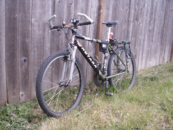
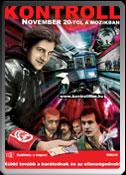 Today my mom dragged me out to see this wonderful film, called Kontroll. This film was shot entirely in the Budapest Subway, and is a fictional story of the trials and tribulations of a group of "honor system" ticket inspectors. I thought this film was quite entertaining, and it had a cool soundtrack. I highly recommended it to any who have a chance to see it. It's playing at the Varsity Theater in Seattle, I think through the end of this week.
Today my mom dragged me out to see this wonderful film, called Kontroll. This film was shot entirely in the Budapest Subway, and is a fictional story of the trials and tribulations of a group of "honor system" ticket inspectors. I thought this film was quite entertaining, and it had a cool soundtrack. I highly recommended it to any who have a chance to see it. It's playing at the Varsity Theater in Seattle, I think through the end of this week.
The film website: http://www.kontrollfilm.hu/
A Review: http://www.seattleweekly.com/features/0521/050525_film_attractions.php
Also, happy Memorial Day
May 25, 2005
Today's News
Speaking of taxes, the Washington State Legislature recently passed a gas tax and vehicle-weight fee increase to fund a bunch of transportation improvement projects. The first gas tax increase of 3 cents will go into effect this July, eventually increasing to 9.5 cents after a number of years. I support usage-based taxes rather than using the general fund for transportation improvements; the gas tax is a good form of a usage tax that is easily implemented. This way, if you drive more you pay more; seems fair, right? An added bonus is that people with SUV's, RV's and other gas guzzlers (typically, a more-affluent crowd) have to pay more, creating a form of Carbon Tax that helps reduce emissions of greenhouse gasses. I am also happy with the list of projects that were selected for funding from this gas tax. WSDOT rightly prioritized maintenence and safety improvements over highway capacity increases, and also included some good transit and rail projects.
April 18, 2005
Today I would like to point out some of the advantages of using the most efficient form of transportation to get around, the bicycle:
Eat Your Fuel
Yesterday I gave a presentation to a graduate level Transit Planning class, CEE 589, at the University of Washington. My talk was about various kinds of projects to improve transit speed & reliability, focusing mainly on bus stop consolidation and some about transit signal priority. You can download the Powerpoint that I used, but be warned that the file is over 22 Mbytes.
Yeah, I know that the 1st quarter of 2005 has passed and that I should start a new page, but I have decided to do this three times a year instead of the four that I was thinking earlier. I'll coordinate it with the Metro service change because that makes everything easier, so they tell me. Besides, 3 is a good number and I don't think this page is full yet.
It allows you to bypass the stipid "free registration" that some websites require, e.g. www.nytimes.com and the archives under www.seattletimes.com
The next day, our goal was to scramble up to Mt. Blum, elev 7680'. The Becky Book* indicates that there is a scramblable route along the Northwest Arm, although in typical Becky style, the route description is rather vague. We packed up a day pack and continued our trek up the Baker River to the confluence of Baker River and Bald Eagle Creek. From here, we followed game trails up to and along the spine of the ridge. On the topo map, it appeared that this ridge climbed at a reasonable grade, however at about the 3500' level, the terrain became very steep. In addition to the steepness, there was about 12" of snow making the footing slippery and unpredictable. We decided to bust out our lunch and call it a day at this point, since further travel would only bring misery and the fog looming above us would eliminate the possibility of views. So we retraced our steps, more or less, and returned to camp upon nightfall. At this point the roof of our cedar room had became saturated and began to leak. Evan's space pod, though, kept us warm and dry at night.
Sunday, we packed up our moist gear and headed back to the trailhead in quick time. On the way out, we made a short detour for a soak in Baker Hot Springs. All thoughts of the cold rainy days of past disappeared.
* Becky, Fred. Cascade Alpine Guide; Rainy Pass to Fraser River. The Mountaineers, 1981.
The Mt. Si trail gains 3500' of elevation in 4 miles, which I chewed through in about 90 minutes. When the scenery wasn't interesting enough to watch, there were the people and dogs, in large numbers and variety. I encountered dogs ranging from an extra-large longhaired Malamute to a Wiener dog, neither of whom seemed very happy to be on this path. I also experienced the pleasure of twice stepping in piles of scat deposited by said creatures. There was an interesting assortment of people, including several groups of German tourists, large Japanese families, some Indian folk, parents yelling at their misbehaving children, and of course the requisite suburbanites decked out head-to-toe in REI gear. The lower viewpoint at the summit was a zoo, but the upper "haystack" reached via a steep scramble was much more mellow. Once reaching this point, I busted out the pint of Bitburger Premium Beer that I hauled up and savored the view. There was no snow anywhere on the mountain.
The return trip was the same in reverse, only faster. The bus ride home provided an excellent opportunity for a nap, and I was home before sundown.
In other news, today is my birthday. You all must feverishly celebrate my existence on this day.
Plan B was to become a bum and travel for a few months. That is still on the long-term agenda, although that will now have to come later.
Anyway I was discussing the possible use of a carbon tax to help reduce greenhouse gas emissions. The idea of a carbon tax is to impose a certain amount of tax to any fossil fuel or other product that will contribute to the global warming problem. Such a tax would reduce demand for these damaging products, would make alternative fuels more viable and also cheaper, and could create a source of funding for various uses (more on that in a bit).
How much would this carbon tax need to be to reach the Kyoto target and how would that affect our daily lives? To help answer that, I will borrow from economic theory the concept of price elasticity. Price elasticity relates a change in price of a certain good to the resulting change in demand, and can be measured in the short term or long term. More info about price elasticity on Wikipedia. An economic research report, conducted by none other than OPEC, pegs the price elasticity of oil at -0.061 in the short term and -0.453 in the long term*. So if we are trying to achieve a 7% reduction in carbon emissions through a reduction in oil use, and we call this a long-term goal, then a 15% increase in price will achieve the target. Now we can look at gasoline prices, which many of us follow closely and is posted all over our neighborhoods. The current price is about $2.00/gallon, a 15% increase would raise that to $2.30/gallon. So there's your economic impact, in a crude nutshell. In my opinion, it's a small price to pay to preserve the Earth's climate.
What do we do with the funds generated by the carbon tax? A logical use would be to invest in research and development of alternative energy sources, to bring their prices down and make them more competitive with fossil fuels. It would also be prudent to invest in public transportation, so that people have more efficient means of getting about. (I know, I'm biased towards transit funding, but I had to throw that out there) There could be a program to help disadvantaged people pay for the higher energy costs. Or, to appease the anti-tax crowd, simply give everyone an equal "energy rebate". All of these funds would create jobs in the homeland, while diverting money from overseas oil cartels.
I admit that this is a highly-simplified analysis and that the real economic impacts would be more far-reaching than the price of gasoline, but I also think that people are adaptable and clever, especially when the financial incentive is there.
* Source: J.B.Cooper, Price Elasticity of Demand for Crude Oil: Estimates for 23 Countries. OPEC Review, March 2003.
This time I coded the track for streaming, so you don't have to download it before listening. Let me know if it gives you any trouble.
So how do we reduce emissions of greenhouse gases anyway? Carbon dioxide is the main culprit, but it is a tricky pollutant to reduce because it is an inevitable by-product of combustion; there is no device that you can stick onto the end of your tailpipe to get rid of the carbon dioxide. You also exhale carbon dioxide with each breath you take, however it is only the combustion of fossil fuels (oil, natural gas, coal) that introduces new carbon dioxide into the Earth's atmosphere. When carbon dioxide is released from the combustion of biofuels, such as biodiesel, ethanol, and breakfast, an equivalent amount of carbon dioxide was already absorbed by the plant that was grown to produce the fuel. So there are really only two simple ways to reduce greenhouse gas emissions, reduce the amount of total energy that we use, or to switch to non-fossil fuels (i.e. renewable energy).
This is not an impossible goal, there are numerous ways that individuals, companies, and governments can reduce carbon dioxide buildup in the atmosphere. There is one way in particular that is physically quick and easy to implement (although currently politically challenging): a carbon tax. The idea of a carbon tax is to slap on an additional tax to any product that is derived from fossil fuels and will contribute to global warming. This would reduce the demand for fossil fuels, increase the demand and viability of alternative fuels, and would provide funds for research and development of alternative energy sources. But how much of a carbon tax would we need to achieve the Kyoto Protocol reduction goals and what would the impacts be? I have some ideas and numbers to answer that question, but it is getting late and I will have to continue this topic another day.
March 23, 2005
Check this:
Bug Me Not
http://www.bugmenot.com/
It even has a plug-in for Firefox that you can use to fill in the forms automatically.
March 22, 2005
Last weekend, my friend Evan and I went on a 3-day hiking/scrambling/exploring trip along the Upper Baker River in the North Cascades
National Park. We must have picked the rainiest weekend of the entire winter. We started at the trailhead near the eastern end of
Upper Baker Lake, which is a reservoir that is used to generate power by Puget Sound Energy. The official trail along the Baker River
continues only for a puny 2.5 miles, to Sulphide Creek, which must be forded in order to travel further along Baker River; we hopped rocks and logs without any problem, helped by the unseasonably low streamflow. On the other side of Sulphide Creek, we intercepted an old trail that continued for another 1.5 miles or so before abruptly ending at a washout. Past this point, we followed the gravel bars along the river and bushwhacked another 2 miles. Through this valley is a rare untouched lower-elevation old growth forest with immense Cedars, Firs and other trees; an ecosystem that has almost completely vanished elsewhere due to logging and development. We picked out a site for a base camp under a huge Cedar covered with moss, it was almost like a room under that tree. We explored some beautiful waterfalls coming off of some nearby cliffs, made dinner, and got a good night's rest in Evan's space pod-like tent. It rained all through the night, but the inside of our Cedar room was still dry in the morning.
BlumMarch 14, 2005
Last weekend I climbed the popular Mount Si trail. This trail has the distinction of being one of the closest trails of significance to the greater Seattle area, and as such is popular year round, it literally swarms with people on a nice sunny day like last Saturday. The intent of my trip wasn't to push my boundaries, explore new territory, or find solitude. Rather, the attractive feature of this trail is that I could get to the trailhead easily without driving. From my house, a quick one-mile bike ride brought me to the I-90 flyer stop at Rainier Ave S, where I boarded my bike and myself onto the route 554 bus. This bus whisked me to the Issaquah P&R, where I transferred to a route 209 bus which conveniently has a schedule synchronized to the 554 (actually this "bus" is an 18-seat van, but it does feature the all-important bike rack). The 209 winds through Issaquah, Preston, Fall City, Snoqualmie, and finally North Bend where I unloaded my bike. From there it was a quick 3 mile ride along a railroad grade and county road to the Mt Si trailhead. The 209 also serves the Tiger Mt. trailhead and Snoqualmie Falls, but it unfortunately doesn't run on Sundays.
The Mount Si ZooMarch 7, 2005
My efforts to apply for a permanent version of my job have been successful! Although I worked for over four years at King County Metro in the Speed & Reliability group, my status was a temporary employee and due to expire soon. To get a permanent position, my boss used her bureaucratic prowess to create an opening for a new position. This opening had to be posted externally and I had to compete for it with other applicants. Ah, the joys of working for the government. My resume and interview kicked all of the other applicant's butts and I got the job.
Job of PermanenceMarch 3, 2005
OK, so it took me more than a few days to follow up on that topic I started two weeks ago about the Kyoto Protocol. I have been busy preparing for a job interview (for a permanent version of my current job) and trying to fix a bunch of things that needed a little mechanical attention; you should see how I managed fixed these headphones, they needed quite a bit of love.
Discussion of the Carbon TaxFebruary 17, 2005
Before I continue yesterday's topic, take a break and enjoy some music:
Intermission
Shakta - Next Stop Kawaguchi
February 16, 2005
Today is the day that the Kyoto Protocol goes into effect. The Kyoto Protocol is an international agreement to reduce emissions of
the greenhouse gases that cause global warming. This agreement was approved by a majority of the world's nations, with the United
States being a glaring exception. The Clinton administration had been working on our part of the agreement, which included the goal
of reducing these emissions by 7%, however, Bush promptly threw out the agreement when he took office in 2001. The reasons the Bush Administration cites for canceling U.S. participation in the Kyoto Protocol are along the lines of "well, China doesn't have to do anything" (developing nations were exempt from the initial reductions) and "it will hurt the economy." This is childish and selfish, and the rest of the world is right for thinking of us as such. The dangers of global warming are too numerous to describe here; instead I will refer you to an earlier blog entry for a discussion of climate change.
Kyoto Protocol: Day One.February 9, 2005
A few items to report from last weekend:
Miscellaneous Items.
January 29, 2005
Went to Green Mountain today, near the Suiattle River in the Glacier Peak Wilderness. Posted this report to the WTA website:
Trip to Green Mountain.
I Took advantage of the feeble snowpack and went for a hike/snowshoe trip to Green Mountain today. It was a lovely day, except for the lack of view at the top. Picked up a hitchhiker on the way in Arlington, it's too bad that CT stopped running bus service to Darrington on weekends, gotta help out the locals here. The Forest Service road conditions webpage reported that the Green Mtn road is driveable for 4 miles, but I found the entire 6 miles quite drivable all the way to the trailhead at 3400' elev . There was one tight squeeze where a Ford Excessive might have trouble.Got to the trailhead around noon, strapped the snowshoes and ice axe to my pack. I call this a hike/snowshoe because there was no snow to speak of for the first half of the trip; not normal for this time of year. As the trail emerged from the forest, I found myself in a seemingly lifeless meadow, the plants trammeled down by the recently departed snow. I could see why they might call this "Green" Mountain, but now it was more of a light brown. Solid snow suddenly appeared at 5000', and I put on my snowshoes a little bit further up. After passing the small lake, I was in the fog with limited visibility. With map and compass in hand, I tried to follow the general route of the trail. Then around the 6000' mark, I encountered a steep exposed draw; the ice axe came in very handy here. At the top, 6500', the only evidence of the lookout was a piece of re-bar poking up through the snow; if not for that clue, I might have not noticed that I was at the top because there was complete white-out. There I located a somewhat sheltered place to sit and then devoured a Vietnamese tofu sandwich.
Going down, I just followed my tracks and employed some butt glissade technique, whee!. Got back to trailhead around 5:00 just as it was getting dark. This is a good jaunt to go out and do while the snowpack is low, the trail is easily followed through the forest, and the terrain is pretty open above the snow line.
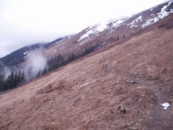
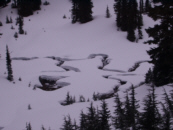
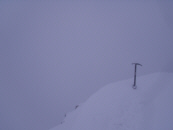
Besides starting over with a fresh copy of WindowsXP on a clean hard drive, I also took this opportunity to try out some new web browser and email software, of the open-source variety. I hereby give up use of Microsoft Outlook Express in favor of Mozilla Thunderbird; and Mozilla Firefox is now my default web browser. I did have some difficulty with importing my old email from my old Outlook Express. Thunderbird has an import tool, but it assumed that the new copy of Outlook Express that Windows just installed was my "old" mail program, and it diligently imported the one "Welcome to Outlook Express" message; it did not give me the option to specify that the messages were stored on another drive. However, after I manually deleted the new "old" outlook express message folder (hopelessly buried in a sub6-folder) and ran the import tool again, it prompted me for the location of the message store, and I could point it to my vast cache of semi-sorted email on my old hard drive. Other than that small speed bump, both Mozilla projects seem to work well.
I also made an interesting discovery within the Windows registry. At the following two locations there is a listing of programs that run when windows starts:
HKEY_LOCAL_MACHINE\SOFTWARE\Microsoft\Windows\CurrentVersion\Run HKEY_LOCAL_MACHINE\SOFTWARE\Microsoft\Windows\CurrentVersion\RunServicesHere I found some useless system tray programs, such as the Quicktime quicklaunch program, and some spyware/virus annoyance that infected my system before I had a chance to download the Windows updates. I suggest that all Windows users check this part of the registry and delete items that seem like they shouldn't belong.
As you begin the 2005 legislative session, a topic that will undoubtedly surface to the forefront is a major transportation project funding measure, likely to be put before the voters. Choosing which projects to place in this measure is critical for success of the package and for the future of the state. During this process, I strongly encourage you to consult the Metropolitan Transportation Plan (MTP) that was developed by the Puget Sound Regional Council (PSRC); this report is called "Destination 2030." For the Puget Sound metropolitan region components of the funding package, choose projects that are in-line with the conclusions and recommendations of "Destination 2030." There are many stakeholders that actively lobby for funding for specific transportation projects; the PSRC reports are the most unbiased, forward-thinking sources for transportation planning information and were written by some of the best experts in the field, based on historical data and experience.
I have voted against previous transportation funding packages because they have not fit in with the regional vision. Specifically, they have included too much money for expansion of urban freeways, and not enough money for transit alternatives. Safety improvements, maintenance of existing roadway facilities, and some rural and freight projects are wise investments. However, the addition of more general-purpose lanes onto the urban freeway system has proven to be a poor use of public dollars, as well as damaging to our health and long-term quality of life.
I am a transportation engineer currently employed by King County. I have a Masters Degree in Transportation Engineering, from the University of Washington, and I recently earned my Professional Civil Engineer's license. I have lived in the Puget Sound Region nearly all of my life and I care deeply about its future.
Thank you for your consideration.
Sincerely,
Owen Kehoe
cc:
Washington State House Transportation Committee,
Washington State Senate Transportation Committee
January 11, 2005
The dispute about the election for the next Washington State governor continues. The election had a razor-thin margin and the Republican Dino Rossi was in the lead until votes were discovered during a hand-recount, which put the Democrat Christine Gregoire into the lead. The Democrats were crying Recount! Recount! until the results tilted to their favor. And now the Republicans are bringing out dead grandmothers to prove that the election results are fraudulent and should be thrown out. The fact is, the election was statistically a tie.
A Governor for WA?
I propose that we settle the election with a Washington State history quiz, to be written and administered by the top state historian. In the case of a "tie," the candidate that can prove to be the most knowledgeable of our area's rich history should be given the state's top job. In fact, I propose that all future elections with a less than 1% margin be settled in this way.
That is all.
January 6, 2005
Happy belated New Year! This year started off on a happy note for me. A New Years Eve festivity that my friends at Environmental Structures and I had been planning turned out to be a resounding success. The gathering was called Omniversity and was a benefit for Climate Solutions. We raised over $800 for them and everyone seemed to have a good time. Such a good time was had that the stroke of midnight was barely noticed, hehe. Now, it's back into the grind of work for me.
Year 5 of the Millennium
To wrap up the end of 2004, I'll share one of my favorite finds of last year: Alternate Version - Keberos. This is a nicely demented Goa Trance track from the compilation Time and Space, Part 2. Enjoy
I needed to start a new page on the OK Blog to prevent it from becoming one overwhelmingly large page; I think I will do this quarterly. You can still find the 2004 entries on the 2004.4 archive page.
© 2005 Owen Kehoe
Route feedback to: